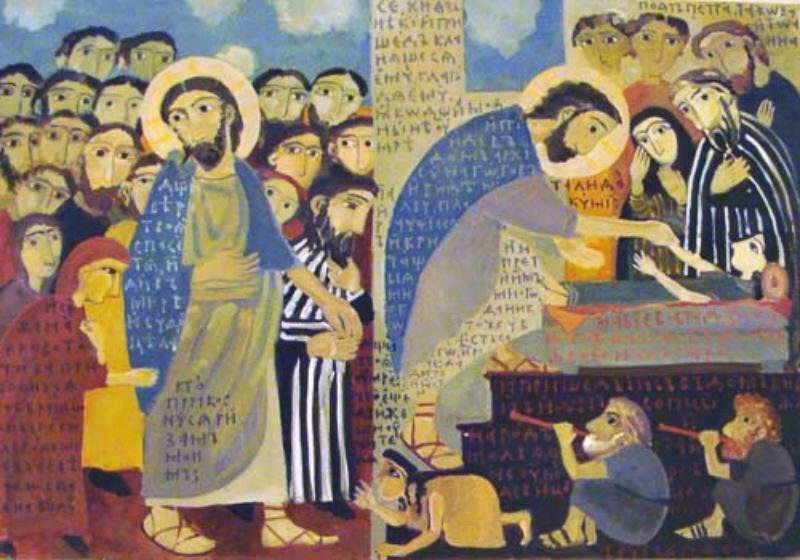Today’s story is a two for one, a parallel weaving together of the story and salvation of two people at the end of their rope. The narrative wrestles with questions of how our identity is defined, what healing looks like, how we believe and forces us to recognize our own expectations of how the Holy One should be and should serve us.
Chiastic in structure, this larger text is in fact two stories: an outer one (the daughter of Jairus), interrupted by an inner one (the bleeding woman). As you read and hear it do you recognize the repetition: the number 12, the word daughter, the use of the word “immediately,” the presence of the crowd pressing in, and the motions of prostrating oneself – or falling to ones knees; and the opposite movement of being raised or lifted up. Throughout the double story the crowd is present – squeezing around Jesus, held together by him, and eventually dispersed by their shared jeering of his attitude. It’s clear the story-telling has been carefully crafted by Mark, even if the wording is sparse and concise.
Jairus is a man of religious authority, and hence great importance in the culture. He comes to Jesus to ask for help, recognizing the latter’s authority by falling to his knees before him, entreating and begging him to have mercy and to intervene. The goal of his prayer for help is healing, wholeness and life. Jesus acquiesces, which seems natural, who wouldn’t help out a notable person and thus grow their influence? But along the way he’s interrupted by an unnamed woman who steals a miracle.
The anonymous woman is defined by both her suffering (12 years of hemorrhaging, or losing blood – quite possibly the longest menstruation ever which makes her ritually unclean and thus banished from all social contact and isolated from her people, home and sanctuary :: see Leviticus 15:19-33) – and her determination to be made whole and live (she’s spent all her income and all her hope in false medical remedies). At the end of her rope. Banished from society by her illness – seen as spiritual unwholeness in their culture – she breaks all the rules, abandoning all restraint to sneak in and up to steal a miracle, to touch the clothing of Jesus – hoping that such a potential indiscernible action will be enough. She is healed, made whole, brought back to life – beyond her wildest dreams. The bleeding stops. And Jesus recognizes her, outs her, requires her to be publicly acknowledged as healed – which means she’s also publicly recognized as “clean” and whole as well as a daughter of Jesus and a woman of great faith. The description of her in v. 33 makes me think of Paul’s words in Philippians 2:12-13
“Therefore, my beloved, just as you have always obeyed me, not only in my presence, but much more now in my absence, work out your own salvation with fear and trembling; for it is God who is at work in you, enabling you both to will and to work for his good pleasure.”
She may have been at the end of her rope, but Jesus is weaving her story into a larger narrative of how God works in the world.
Finally arriving at the home of Jairus, they learn the girl is dead. I wonder if he was irritated, peeved that Jesus has spent valuable time on an unnamed, unimportant woman while en route as opposed to hurrying to his house to help his daughter. Jesus invites him to not fear, but to believe – to trust (notice the invitation to become like the bleeding woman in v. 33). The crowd seems to go wild, they jeer and laugh at Jesus, mocking him to the point that he puts them outside. Their expectant pressing has become the final straw. The girl is raised up – the word means both to awaken, to raise physically up, and to raise up to new life (resurrect).
Both stories then articulate visions of resurrection, becoming truly alive through belief, not so much in dogma or doctrine, but in trusting Jesus, trusting God’s good intent and desire for all people to be whole, healed and fully alive.
Questions for going deeper:
- What word phrase or image in the text shimmers for you?
- How does it intersect with or touch your life today?
- What invitation do you hear to be, act, speak or relate in today’s text?
